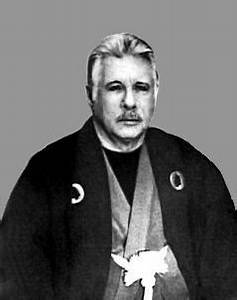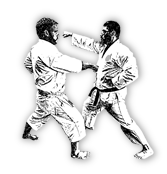
Early years:
Shuri-ryū is the collective teachings of Robert A. Trias. The roots of Shuri-ryū are from Okinawa and China. The styles/arts that had the greatest influence on Shuri-ryū are Okinawan Shōrin-ryū, kenpō, goju-ryū, Japanese shotokan, and Chinese xing-yi and baguazhang.
Trias ōsensei began his study of Asian martial arts while in the US navy. His first instructor, Tong Gee Hsing, taught him a combination of Chinese xing-yi and Okinawan Kenpō. Though his time with Hsing was short, it was impactful. He also studied jūjitsu in Singapore with Hoy Huan Ping and Okinawan kenpō in Hawaii with James Mitouse.
After serving in World War Ⅱ, Mr. Trias returned to Arizona and worked as a state trooper. But he had fallen in love with martial arts and karate. He opened the first professional karate dōjō in America in 1946 and began teaching what he had learned. An Arizona Supreme Court justice confirmed this with a letter because he was an early student of Trias ending any debate on who was first to open a karate dōjō.
Trias ōsensei continued to learn all that he could. Early on, he named his style Shorei-ryū or Shorei-gōju-ryū. Mr. Trias continually took trips to the orient to continue his studies. After some time he became the student of Yasuhiro Konishi sensei. Konishi had been a direct student of both Funakoshi Gichin and Motobu Chōki. This relationship continued until Konishi’s death, where Makato Gima sensei became Mr. Trias’ teacher. Before his death, Konishi sensei asked Trias to rename his style to Shuri-ryū and to realign many elements to the Shuri methods. Konishi wanted Trias to help preserve the Shuri name and Shuri traditions.
The first person outside of the hombu dōjō (headquarters) to promote from ikkyū to shodan under these new standards was Joseph Walker shihan.
Eight performance categories of Shuri-ryū:
- Kata/bunkai – forms (3 levels)
- Ippon kumite kata – single fighting methods
- Taezu naru waza – constant practice methods
- Kihon kumite kata – basic fighting methods
- Jiyu undō– free exercise
- Kata kumite – form sparring
- Kime dachi – focus stance sparring
- Jiyu/sessen kumite – free sparring and close battle sparring

After Trias ōsensei’ death:
On a trip to Asia, Trias ōsensei found out he had cancer. He was told by doctors, he would only live for 2 weeks. He immediately returned home. After returning home, he was told he would live for about 2 month. Trias ōsensei lived for about two years. During this time his goal was to teach all he had learned.
On July 11, 1989, Trias ōsensei passed away. This was only a few days before the USKA world championships were to be held. Many of his students were coming to gather for the tournament. The news hit them hard. The tournament was still held in his honor.
Later, Walker shihan received Trias ōsensei’s death scroll from the kosho-ryū naming Trias “Basho” or “the great pine.” This scroll was sent on to Trias ōsensei’s daughter Roberta Trias-Kelley.
Shuri-ryū patch:

The “pine tree” patch worn on the left sleeve easily recognizes Shuri-ryū stylists. This patch was created by Robert Trias to show the individuals who have learned and tested on the standards of Shuri-ryū.
Level 1 – kyū ranks. The patch is a green background and a white pine tree, border, and writing. It is earned at the rank of shichikyū (yellow belt).
Level 2 – dan ranks. The patch is a green background and a black pine tree, border, and writing. It is earned at the rank of shodan (1st degree black belt).
Level 3 – Assistant Chief Instructor. The patch is a green background and a black pine tree and writing with a red border. This is earned by only a few. One must be nominated and pass multiple exams.
Level 4 – Chief Instructor. The patch is a green background and a black pine tree and writing with a red border and a red sun. These people are the leaders of Shuri-ryū who help ōsensei propagate Shuri-ryū.
Patch symbolism:
- Pine tree – stands for strength, longevity, and endurance
- 3 roots – stand for the 3 men who founded the system: Motobu Chōki, Tong Gee Hsing, Robert Trias – forms/speed/power – body/mind/spirit
- Trunk of the tree – stands for the Chief Instructors of Shuri-ryū
- Branches – stands for students of Shuri-ryū – growth and progress – the belt ranking system
- Red sun- stands for bursting forth of new knowledge. The chief instructors give life to the system
- Green – stands for tranquility and everlasting
- White – stands for purity
- Black – stands for steadfastness
- Red – stands for courage
- The circle – stands for everything returning to the source
What is strength?
When talking about the Shuri-ryū patch and discussing strength, the least important type is physical strength. It is a byproduct of true strength i.e. mental strength. Mental strength can be described with many different words that when combined together are true strength. Self-discipline, fortitude, self-control, determination, perseverance, loyalty, honor, compassion, humility, wisdom, moral character, principled, work ethic, courage, and patience would all be attributes of a strong person. So then weakness must be the opposites. Impulsive, a weak will, immoral, self-indulgent, bully, lazy, and impatient would all descriptions of a weak person. Shuri-ryū karate-ka need to focus on the development of these positive virtues. Through the training of Shuri-ryū and cultivating these virtues we can grow in our physical and mental strengths. Through this growth, we can become leaders of ourselves and those around us.
Shuri-ryū Chief Instructors:
In 1975, Trias ōsensei created the position of Chief Instructor of Shuri-ryū to act as leaders and guides for the system. Their job is to lead and grow Shuri-ryū. They are involved in the promoting of yudansha, training teachers, and school heads. The first people named to this position were Roberta Trias-Kelley, Phil Koeppel, Robert Bowles, Pete Rabino, Victor Moore and Mike Awad.
The International Shuri-ryū Association is the core of this group appointed by Trias ōsensei. This body has continued in Trias ōsensei’s footsteps and taken the lead in expansion of Shuri-ryū and in appointing Chief Instructors and Assistant Chief Instructors. The first person raised under the ISA to Chief Instructor was Joseph Walker shihan.
Active International Shuri-ryū Association Chief Instructors:
- Robert Bowles, 10th dan, student of Trias ōsensei, an original chief instructor
- Pete Rabino, 9th dan, student of Trias ōsensei, an original chief instructor
- Dale Benson, 9th dan, student of Trias ōsensei, chief instructor under Trias ōsensei
- Sandra Bowles, 9th dan, student of Trias ōsensei, raised to chief instructor in the ISA
- Joseph Walker, 9th dan, student of Trias ōsensei, appointed assistant chief instructor by Trias ōsensei in 1989, first person raised to chief instructor in the ISA
- George Sheridan, 8th dan, , student of Trias ōsensei and Pete Rabino, raised to chief instructor in the ISA
- Tony Bisanz, 8th dan, student of Trias ōsensei and Dale Benson, appointed assistant chief instructor by Trias ōsensei in 1989, raised to chief instructor in the ISA
- Glen Wallace, 7th dan, student of Robert Bowles, raised to chief instructor in the ISA
- Lon Bradfield, 7th dan, student of Robert Bowles, raised to chief instructor in the ISA
- Neils Larson, 7th dan, student of Vitus Bilking, raised to chief instructor in the ISA
- Luis Lugo, 7th dan student of Robert Bowles, raised to chief instructor in the ISA
- Gustavo Lugo, 7th dan, student of Robert Bowles, raised to chief instructor in the ISA
- Todd Sullivan, 6th dan, student of Robert Bowles, raised to chief instructor in the ISA
- Joseph Johnston, 5th dan, student of Joseph Walker, raised to chief instructor in the ISA
Active International Shuri-ryū Association Assistant Chief Instructors:
- Rick Scoppe, 7th dan, student of Ridgley Able, raised to assistant chief instructor in the ISA
- John Venson, 9th dan , student of Trias ōsensei and his father also named John Venson, raised to assistant chief instructor in the ISA
- Donna Judge, 8th dan, student of John Pachivas, raised to assistant chief instructor in the ISA
- Joe Pounder, 6th dan, student of Ridgley Able, raised to assistant chief instructor in the ISA
- Amanda Kauffman, 5th dan, student of Robert Bowles and Joe Hurtseller, raised to assistant chief instructor in the ISA
- Reggie Venson, 6th dan, student of John Venson, raised to assistant chief instructor in the ISA
- John Wong, 6th dan, student of Donna Judge, raised to assistant chief instructor in the ISA